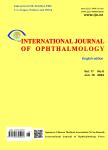Microvascular changes after conbercept therapy in central retinal vein occlusion analyzed by optical coherence tomography angiography
Microvascular changes after conbercept therapy in central retinal vein occlusion analyzed by optical coherence tomography angiography作者机构:State Key Laboratory of OphthalmologyZhongshan Ophthalmic CenterSun Yat-sen University Wuping Hospital The Second Affiliated Hospital of Harbin Medical University The People's Hospital of Gaoyao District
出 版 物:《International Journal of Ophthalmology(English edition)》 (国际眼科杂志(英文版))
年 卷 期:2019年第12卷第5期
页 面:802-808页
核心收录:
学科分类:1002[医学-临床医学] 100212[医学-眼科学] 10[医学]
基 金:Supported by National Natural Science Foundation of China(No.81570830)
主 题:central retinal vein occlusion optical coherence tomography angiography macular edema conbercept vessel density flow area foveal avascular zone
摘 要:AIM: To investigate microvascular changes in eyes with central retinal vein occlusion(CRVO) complicated by macular edema before and after intravitreal conbercept injection and evaluate correlations between these changes and best-corrected visual acuity(BCVA) and retinal thickness. METHODS: Twenty-eight eyes of 28 patients with macular edema caused by CRVO were included in this retrospective study. All patients received a single intravitreal conbercept injection to treat macular edema. BCVA and the results of optical coherence tomography angiography(OCTA) automatic measurements of the vessel density in the superficial(SCP) and deep retinal capillary plexus(DCP), the foveal avascular zone(FAZ) area, the FAZ perimeter(PERIM), the vessel density within a 300-μm wide ring surrounding the FAZ(FD-300), the acircularity index(AI), the choriocapillaris flow area, and retinal thickness were recorded before and at one month after treatment and compared with the results observed in age-and sexmatched healthy subjects. RESULTS: The vessel density in the SCP and DCP, the FD-300, and the flow area of the choriocapillaris were allsignificantly lower in CRVO eyes than in healthy eyes, while the AI and retinal thickness were significantly higher(all P0.05). After treatment, retinal thickness was significantly decreased, and the mean BCVA had markedly improved from 20/167 to 20/65(P=0.0092). The flow area of the choriocapillaris was also significantly improved, which may result from the reduction of shadowing effect caused by the attenuation of macular edema. However, there were no significant changes in SCP and DCP vessel density after treatment. The flow area of the choriocapillaris at baseline was negatively correlated with retinal ***: OCTA enables the non-invasive, layerspecific and quantitative assessment of microvascular changes both before and after treatment, and can therefore be used as a valuable imaging tool for the evaluation of the follow-up in CRVO pat



